Alarm over rising cases of child labour and trafficking

Child protection networks have flagged rising cases of child trafficking and forced child labour in the country.
The networks are further concerned by the reality that Kenya is increasingly becoming a conduit for cross-border labour migration involving minors.
National Government coordinator Children Services in charge of Mombasa county Gabriel Kitili, regretted that in the past one year, Mombasa alone recorded 5,000 cases of child exploitation related cases with national survey pointing to over one million children.
Kitili regretted that the vice has been attributed to the rising number of street families with 2018 data indicating that Mombasa has 7,529 street persons who are prone to trafficking. He further attributed the higher unemployment levels as the major contributor to the rising vice.
Speaking at a stakeholder engagement meeting convened by the international labour Organisation (ILO) in Mombasa, Kitili said the county’s plan to remove street begging and street hawking has begun in earnest.
Mombasa is planning to develop a standalone child labour policy, which is going to be one of its kinds in Kenya to address the rising vice. Leading sectors in child abuse is in Agriculture and transport sector.
“We are exploring ways to remove the children from the streets, without necessarily having to conduct a crackdown, we intend to conduct sensitisation to the public to stop giving handouts, to discourage street begging,” said Kitili.
Grace Mbanya International labour organisation (ILO) regional project manager for Uganda and Kenya regretted that cases of labour migration trafficking are on the rise despite key innervations by respective governments.
“Mombasa is one of the counties which are proactive, they started by passing a motion that says no to child labour, now they are formulating a law on child labour policy, and this is part of the interventions to solve,” said Mbanya.
The meeting in Mombasa brought together stakeholders from different sectors including government, county, civil society groups and media to discuss ways to stop child labour, forced labour and human trafficking.
Migration systems
“Globally according to ILO report we have 160 million child labourers with 90 million being from Sub-Saharan Africa, where Kenya falls, and the report says a younger group of 5-17 are in child labour with the majority being boys,” said Mbanya.
She said young women migrating to the Gulf unknowingly end up in trafficking situations even with labour migration systems being put in place by the government. She said many young gills are duped about good deals which change after reaching destinations.
“As you may know the face of child labour changes over times, it used to be in hawking, now it’s in agricultural farms in sugarcanes, there are more children now on the streets and this is child labour, we are finding more boys in the bodaboda business, and the latest trade which is online,” said Mbanya.
The ILO, Banya said, is also influencing county budgetary processes to channel adequate funds towards the enactment of laws, advocacy campaigns, and ensuring enforcement measures to end child labour, sexual exploitation, and trafficking in the country.
She said ILO is also partnering with the Ministry of Labour and the Kenya National Bureau of Statistics to roll out a national survey on child labour to establish the full scale in the country. This, she said, will ensure more progressive, data-informed interventions, measures, and policies are put in place to address and eradicate the vice.









